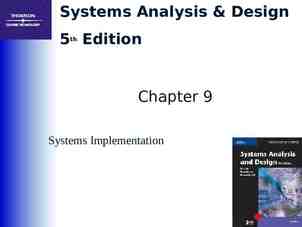Will a Wealthier India be a Healthier India? Jishnu Das,
52 Slides725.00 KB

Will a Wealthier India be a Healthier India? Jishnu Das, Shanta Devarajan, Jeff Hammer, Lant Pritchett

2000 1999 1998 1997 1996 1995 1994 1993 1992 1991 1990 1989 1988 1987 1986 1985 1984 1983 1982 1981 1980 1979 1978 1977 1976 1975 1974 1973 1972 1971 1970 1969 1968 1967 1966 1965 1964 1963 1962 1961 1960 India has been growing rapidly since the 1980s Chart 1. Economic Performance in India 1960-2000 (log scale, 1960 1) 2.5 GDP/capita GDP/worker TFP 2 1.5 1 0.5

And increases in income have translated into

Higher life-expectancy (population sized circles, India is big blue, China big red

Lower child-mortality

And lower fertility

And yet

There are three good reasons to worry

Reason 1: Improving health outcomes further may require substantially higher investments in public health services Trend of IMR by Selected States in India IM R pe r 1 0 0 0 liv e births 100 90 80 70 60 50 40 30 20 10 0 1994 1995 1996 1997 1998 1999 2000 2001 2002 Year Karnataka Tamil Nadu Overall India Kerala Utter Pradesh Rajasthan West Bengal

where our performance is not stellar (not even lunar) Measles Immunization: 12-23 Months % Immunized 90 85 80 75 70 65 Bolivia China India Indonesia Kenya 60 55 50 2000 2001 2002 Year Source: WDI Indicators Database 2003 2004

Reason 2: Morbidity is taking a toll on India’s productive capabilities Labor and Health in Delhi Women 4.8 2.2 Men 2.1 50th %tile 75th %tile Days Worked per Week 1.9 2 Days Worked per Week 4.4 4.6 90th %tile 50th %tile 90th %tile 1.8 75th %tile 25th %tile 0 .2 .4 .6 .8 % W eeks Sick with an Acute Illness 1.7 4.2 25th %tile 1 Source: Author's Calculations based on ISERDD Data 0 .2 .4 .6 .8 % Weeks Sic k with an Acute I llness 1

Reason 3: and the poorest 20% are not doing that well at all (worse than BGD) Vietnam (poorest 20%) Bangladesh (poorest 20%) India (poorest 20%)

But we have known this for 60 years “If it were possible to evaluate the loss, which this country annually suffers through the avoidable waste of valuable human material and the lowering of human efficiency through malnutrition and preventable morbidity, we feel that the results would be so startling that the whole country would be aroused and would not rest until a radical change has been brought about.” Bhore Committee Report 1946

A Roadmap Three things you should know about the Indian health system (and are fairly well known by now) Four more things you should know about the Indian health system (and are fairly new) What doesn’t work (but is often done) What might work

The Indian health system according to “The Mindset” (at least on record) Basic Care is universally given by the state Most people use public facilities The private sector is just “quackery and crookery” The system is “Pyramidal” Sub center for every 5,000 people PHC for every 30,000 people etc. etc. Integrated referral chain

Mindset (at least on record) Poor people rely on the public system & the benefits of public care mostly accrue to them

In Reality (and this is well known)

Fact #1: Most spending is private; the fraction on genuine public goods is tiny

IF we spend the equivalent of one box on Population based public health . We spend 3 on Preventive Health care 8 on PHC’s Public Curative Care is 20 boxes 12 on Hospitals PHC’s Hospitals And . Private Care “Public health” is 4 boxes Population based public health Preventive/Promotive Public Health

75 Boxes on Private Care!

In fact India is one of the most private systems of health care in the world The Heartless Capitalists Public Health Spending (% of Total) 60 Percentage 50 Chile India China United States 40 30 20 10 0 2000 Source: WDI Database 2001 2002 2003 Year People Power

And its becoming even more private The public share of institutional deliveries (of babies) fell from 57.3 to 48.2% between 1992 and 1998 (NFHS I, II) The public share of all deliveries fell between 1998 and 2001 (RCH I, II) as the private sector’s share rose from 9.4 to 21.5% Recall: Pay commission raises of 1997 makes this unlikely to be due to lack of money – health ministries are very labor intensive

Fact #2: The poor use private care as much as the rich Share of the private sector in number of visits for primary care services - rural areas 100 poorest 80 2 60 3 40 4 20 richest 0 Karnataka Kerala Rajasthan West Bengal All India

Fact #3: More public money on health goes to the rich than the poor (because hospital use is regressive) 35 30 25 Hospitals 20 Primary Health Centers 15 10 5 0 Poorest II III IV Richest

One Reason that is often given to explain why the poor have worse health outcomes Poor people don’t use doctors and health facilities that’s why they have worse health outcomes

But this perceived wisdom is wrong

Recent data show that Households in Rajasthan visit doctors more than in the U.S. – And the differences between rich and poor in visits to health providers is small In Delhi, the poor go to doctors more than the rich Click here to see a table looking at doctor visits from Delhi

Despite the frequent use of health care providers There is no relationship between the presence of health facilities and health outcomes 45 40 35 30 25 20 15 10 5 0 Significant, right sign Not Significant, right sign Not significant, wrong sign Significant, wrong sign Distribution of t-tests of the variable “any public facility in village” on rural infant and child mortality. All states, various specifications, NFHS 1998 (propensity score matching*)

One important question Why don’t the poor use public health facilities more?

4 Reasons based on 4 lesser known facts

Reason 1: Public Doctors in India are among the most absent in the world Absenteeism among health workers 45 40 35 30 25 20 15 10 5 0 Pe ru es on ia d In d In es ia d la da g an n ga B U h

Reason 1 (cont): Absences are never below 30 percent! Absenteeism amongst doctors by state & reasons for absence 80 70 60 50 Official Duty 40 Leave No reas on 30 20 10 0

Reason 2: When public doctors do show up for work, the exert very little effort Competence and Effort R ich M iddle Poor Locality-Income and Institution Private PHC's Hospitals Private What they do PHC's What they know “Effort deficit” Hospitals Private PHC's Hospitals -2 -1.5 -1 Clinical Competence -.5 0 Effort-in-Practice .5

What does “very little effort” mean? 2, 1, 0 7 6 5 4 low effort medium high 3 2 1 0 time Less than 2 minutes questions exams Just one question Almost none!

Fact #3: And public doctors in PHCs are not particularly competent to begin with PHC Doctors are substantially less competent than in TZA(!) or IDN

Reason 4: And you still have to bribe public doctors to do their work Money value of “donation” payments Ration Shops 4% Health 27% Education 12% Taxation& Land Admn. 17% Police & Judiciary 15% Telecom & Rail 5% Power 20%

A summary of why poor people may not be using the PHC system The doctors are low on competence They don’t show up for work When they do show up, they don’t work to the level of their knowledge And patients have to pay bribes anyway

One oft-advocated solution That probably does not work Training Doctors

Training and the Invisible Hand With public doctors, problem is NOT that they don’t know what to do, its that they don’t do it! No public doctor needs training to know that he/she should come to work! Yet

Training and the invisible hand (II) The percentage of essential care given by a doctor with 6 months training in the private sector the percentage of essential care given by a doctor with 5 years training in the public sector

What They Know 0 % Who asked the relevant question .1 .2 .3 .4 .And What They Do Private MBBS Private, No MBBS % Asked (DCO) Public % Asked (Vignettes)

The losses from low effort W hat they D o .4 .6 .8 1 Rotating The Curve Lost Training: Private 0 .2 Additional Lost Training: Public 0 .2 .4 .6 What they said they would do What they know What they do: Public .8 W hat they Do: Private 1

Training and the invisible hand (III) If we train doctors in the private sector, what guarantees that they will practice in ways commensurate with their training?

Practitioner Qualifications and Drug Use 2.7 Tr ai n in g 0.7 R M P/ No 0.1 2.5 H M S 0.5 2.6 0.5 M BB S BI M S/ BA M S/ B UM S/ B 0.5 0.0 0 1 Medicines per patient Alternative Medicines per patient 2 3 Antibiotics per patient

Approaches to a solution India’s public health system bundles five potentially separate components: Hospital-based curative care Ambulatory curative care Prevention and health promotion Health-sector-based public health (disease surveillance, etc.) Non-health-sector based public health (safe water, sanitation)

Each of these is subject to a different market failure Sub-system Market failure Hospital-based curative care Insurance-market failure Ambulatory curative care Prevention and health promotion Merit goods, some externality Health-sector based public health Pure public goods Non-health-sector based public health Externalities

and to a different government failure Sub-system Government failure Hospital-based curative care Political capture by elites Ambulatory curative care Monitoring of effort/quality, asymmetric information Prevention and health promotion Monitoring of effort/quality, logistics Health-sector based public health Non-health-sector based public health No middle-class support for reforms

Matching the sub-system to the market and government failure Sub-system Institutional arrangement Hospital-based curative care Health insurance with autonomous hospitals Ambulatory curative care “Money follows the patient” Prevention and health promotion Devolve to local governments Health-sector based public health Non-health-sector based public health

“The solution” is the problem The “mindset” of universal, hierarchical, poor oriented public production of health care is now only the planner’s fantasy “Deer in the headlights” of reform “System” reform cannot work as there is no coherent system Must be broken to be reset.









